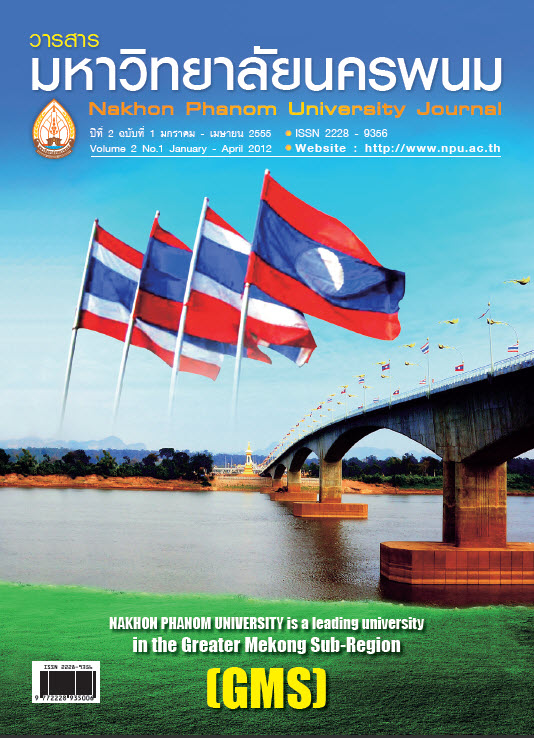การเปรียบเทียบผลสัมฤทธิ์ทางการเรียน ความสามารถในการคิดวิเคราะห์และความคงทนในการเรียนรู้ เรื่อง การบวก การลบ การคูณ การหารจำนวนนับชั้นประถมศึกษาปีที่ 5 ระหว่างการจัดการเรียนรู้โดยใช้การเรียนรู้ด้วยกลุ่มร่วมมือแบบ TAI และแบบปกติ
Main Article Content
Abstract
การวิจัยครั้งนี้มีวัตถุประสงค์เพื่อ 1) พัฒนาแผนการจัดการเรียนรู้คณิตศาสตร์ เรื่อง การบวก การลบ การคูณ การหาร จำนวนนับ ชั้นประถมศึกษาปีที่ 5 โดยใช้การเรียนรู้ด้วยกลุ่มร่วมมือแบบ TAI และแบบปกติ ที่มีประสิทธิภาพตามเกณฑ์ 75/75 2) หาดัชนีประสิทธิผลของแผนการจัดการเรียนรู้ด้วยกลุ่มร่วมมือแบบ TAI และแบบปกติ 3) เปรียบเทียบผลสัมฤทธิ์ทางการเรียน ความสามารถในการคิดวิเคราะห์และความคงทนในการเรียนรู้ระหว่างการจัดการเรียนรู้ด้วยกลุ่มร่วมมือแบบ TAI และแบบปกติ ประชากร ได้แก่ นักเรียนชั้นประถมศึกษาปีที่ 5 ภาคเรียนที่ 1 ปีการศึกษา 2554 ในสังกัดกลุ่มเครือข่ายค้อพัฒนา อำเภอโพนสวรรค์ สำนักงานเขตพื้นที่การศึกษาประถมศึกษานครพนม เขต 2 ทั้งหมด 7 โรงเรียน จำนวน 10 ห้องเรียน รวมทั้งสิ้น 255 คน กลุ่มตัวอย่าง ที่ใช้ในการวิจัย ได้แก่ นักเรียนชั้นประถมศึกษาปีที่ 5 ภาคเรียนที่ 1 ปีการศึกษา 2554 โรงเรียนบ้านค้อ อำเภอโพนสวรรค์ สำนักงาน เขตพื้นที่การศึกษาประถมศึกษานครพนม เขต 2 จำนวน 62 คน จาก 2 ห้องเรียน เป็นกลุ่มทดลอง 31 คน จัดการเรียนรู้ด้วยกลุ่ม ร่วมมือแบบ TAI และกลุ่มควบคุม 31 คน จัดการเรียนรู้แบบปกติ ซึ่งได้มาโดยการสุ่มแบบกลุ่ม (Cluster Random Sampling) เครื่องมือ ที่ใช้ในการวิจัย ได้แก่ แผนการจัดการเรียนรู้ด้วยกลุ่มร่วมมือแบบ TAI และแบบปกติ แบบทดสอบวัดผลสัมฤทธิ์ทางการเรียน ชนิด เลือกตอบ 4 ตัวเลือก จำนวน 40 ข้อ มีค่าความยากตั้งแต่ 0.21 ถึง 0.66 มีค่าอำนาจจำแนกตั้งแต่ 0.23 ถึง 0.86 และค่าความเชื่อมั่น เท่ากับ 0.85 หาค่าความเที่ยงตรงเชิงเนื้อหาโดยใช้วิธีพิจารณาดัชนีความสอดคล้องระหว่างข้อสอบกับจุดประสงค์เชิงพฤติกรรม แบบทดสอบวัดความสามารถในการคิดวิเคราะห์ ชนิดเลือกตอบ 4 ตัวเลือก จำนวน 20 ข้อ มีค่าความยากตั้งแต่ 0.24 ถึง 0.67 มีค่าอำนาจจำแนกตั้งแต่ 0.38 ถึง 0.73 และค่าความเชื่อมั่นเท่ากับ 0.83 สถิติที่ใช้ในการวิเคราะห์ข้อมูล ได้แก่ ร้อยละ ค่าเฉลี่ย ส่วนเบี่ยงเบนมาตรฐาน และการทดสอบสมมติฐานโดยใช้ t-test (Independent Samples) ผลการวิจัย พบว่า 1) แผนการจัด การเรียนรู้ด้วยกลุ่มร่วมมือแบบ TAI มีประสิทธิภาพ เท่ากับ 81.69/80.56 และแผนการจัดการเรียนรู้แบบปกติมีประสิทธิภาพ เท่ากับ 79.63/77.82 2) ดัชนีประสิทธิผลของแผนการจัดการเรียนรู้ด้วยกลุ่มร่วมมือแบบ TAI เท่ากับ 0.6144 คิดเป็นร้อยละ 61.44 และ แผนการจัดการเรียนรู้แบบปกติ เท่ากับ 0.5634 คิดเป็นร้อยละ 56.34 3) นักเรียนชั้นประถมศึกษาปีที่ 5 ที่เรียนด้วยกลุ่มร่วมมือแบบ TAI มีผลสัมฤทธิ์ทางการเรียน ความสามารถในการคิดวิเคราะห์ สูงกว่านักเรียนที่เรียนด้วยการจัดกิจกรรมการเรียนแบบปกติ อย่างมี นัยสำคัญทางสถิติที่ระดับ .05 4) นักเรียนชั้นประถมศึกษาปีที่ 5 ที่เรียนด้วยกลุ่มร่วมมือแบบ TAI มีความคงทนในการเรียนรู้
The purposes of this research were to 1) Develop Mathematics lesson plans on addition, subtraction,multiplication, and division of cardinal number by using TAI cooperative learning and conventional teachingapproaches with a required efficiency of 75/75 for Prathomsuksa 5 students, 2) Investigate effectiveness indices of TAI cooperative learning and conventional teaching lesson plans, and 3) Compare learning achievement, analytical thinking ability and learning retention between using TAI cooperative learning and conventional teaching approaches. The sample group in this research consisted of 62 Prathomsuksa 5 students studying in the first semester of the academic year of 2011 from 2 classes of Ban Kho School, Phonsawan district under Nakhon Phanom Primary Educational Service Area Office 2. They were classified into 2 groups: an experimental and a control groups. The experimental group comprised 31 students using TAI cooperative learning approach and the control group comprised other 31 students using conventional teaching approach. They were selected by Cluster Random Sampling technique. The research instruments used in this research were: 1) Lesson plans of TAI cooperative learning and conventional teaching approaches, 2) 4-choice and 40-item achievement test with a difficulty ranging between 0.21-0.66, a discrimination value between 0.23-0.86 and a reliability of 0.85, and 3) 4-choice and 20-item analytical thinking test with a difficulty between 0.24-0.67, a discrimination value between 0.38-0.73 and a reliability of 0.83. The statistics employed in data analysis were percentage, mean, standard deviation and t-test (Independent Samples). The results showed that: 1) The mathematics lesson plans using the TAI cooperative learning approach revealed the efficiency of 81.69/80.56 and the conventional teaching lesson plan revealed the efficiency of 79.63/77.82, 2) The effectiveness indices of TAI cooperative learning lesson plans were at 0.6144 which was considered as 61.44 Percentage and the conventional teaching lesson plans revealed 0.5634 which was considered as 56.34 Percentage, 3) The Prathomsuksa 5 students taught by the TAI cooperative learning approach revealed higher learning achievement and analytical thinking ability than those of the students taught by the conventional teaching approach significantly at a level of .05, and 4) The Prathomsuksa 5 students taught by the TAI cooperative learning approach had learning retention.


